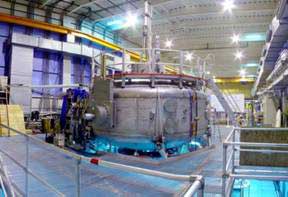Looking to the Stars: Creating Fusion in the Lab
Oil-covered birds and closed beaches are a dramatic reminder of the risks involved in powering our lights, computers, televisions, video games, and other energy-sucking habits with oil. Solar and wind energy are attractive alternatives, but these and other sources of renewable energy can only be part of the solution. Nuclear energy, based on fission, is pollution free and could go a long way toward meeting much of the world’s electricity needs. However, nuclear power plants come with significant safety concerns, and disposing of the waste is difficult and expensive.

Health, safety and environment workers contracted by BP clean up oil on a beach in Port Fourchon, LA, May 23, 2010.
Public domain
Like poets and musicians, scientists are often inspired by the night sky. For some of them the twinkling stars represent more than beauty and mystery—they hold the secret to an enormous supply of practically pollution-free energy.
Fusion Energy
The sun produces HUGE amounts of energy. In just five seconds, the sun gives off an amount of energy equal to the electricity used by the entire world’s population in one year! Before reaching us here on earth, light and heat from the sun has already traveled 93 million miles, and we still need sunscreen. Where does all of this energy come from? Can we produce that kind of energy in a lab?
The center of the sun is extremely hot—more than 15 million degrees Celsius! At this temperature a significant percentage of electrons are no longer bound to atoms, turning the gas into a plasma, a mixture of charged nuclei and particles. Besides stars, you can find plasmas in TV displays, neon signs, lightning, and the Northern and Southern lights.
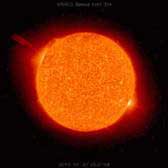
Arcs rise above an active region on the surface of the Sun in this image taken by the STEREO spacecraft. The arcs are plasma, superheated matter made up of moving charged particles (electrons and ions).
Image courtesy of NASA/STEREO Science Center
The temperature of a gas determines the speed of the particles in the gas, thus particles in a very hot gas move very fast. When they are contained in a small volume, some of the fast-moving nuclei eventually run into each other and “fuse” together. Their fusion creates the nucleus of a heavier element and a free neutron, and releases a large amount of energy.
In his famous equation E=mc2, Albert Einstein showed that mass (m) can be changed into energy (E) and vice versa. The c2 in the equation stands for the speed of light squared (a really big number). Einstein’s equation says that a little bit of mass can turn into a huge amount of energy. When two nuclei fuse, some of their mass (m) turns into energy (E) according to Einstein’s equation. This fusion energy powers the sun.
Continue reading to find out about some tools scientists at the Massachusetts Institute of Technology (MIT) Plasma Science and Fusion Center (PSFC) are using to study the feasibility of fusion energy power plants.
Research
Initiating a process only found in the core of a star in the laboratory is a challenging task. Creating fusion energy involves heating a gas to around 100 million degrees Celsius, and then containing the plasma in a fixed volume. This is tricky because the plasma is so hot that it will destroy metal or any other material used to make walls. However, if the plasma is not contained within a small volume then the fast-moving particles will disburse and reduce the likelihood that fusion will occur.
The main hindrance to lab-created fusion as a source of energy is that it takes a significant amount of electrical power to create the hot plasma and sustain the magnetic fields. Scientists are still working to increase the fusion energy output so that it will surpass the input energy of heating and containing the plasma.
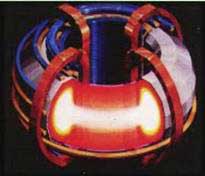 |
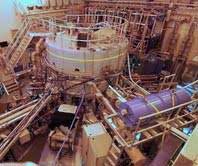 |
|
Tokamak: The doughnut-shaped ("toroidal") magnetic field geometry, characteristic of a tokamak, is used |
A view of the Alcator C-Mod tokamak. |
Scientists at MIT are using Alcator C-Mod to better understand how to confine hot plasma with magnetic fields. Alcator C-Mod is a tokamak, a tool invented by Russian scientists in the 1960’s that has a donut-shaped vacuum chamber surrounded by magnetic coils. Alcator C-Mod is able to create dense, high temperature, well-confined plasmas with a magnetic field more than 100,000 times stronger than the Earth’s magnetic field. By adjusting the magnetic field, scientists are able to control the shape of the plasma, thereby optimizing its stability and confinement.
The science that is being learned from Alcator C-Mod will influence how a new tokamak, ITER, is built, and how to optimize its operation. Currently under construction, ITER is an international fusion project that aims to produce ten times more power than the heating power required to produce the hot plasma. Scientists will also use ITER to study plasmas under conditions that are similar to those expected in fusion power plants.
Researchers at PSFC are investigating the feasibility of another magnetic confinement technique with the Levitated Dipole Experiment (LDX), a joint project between MIT and Columbia University. Inspired by observations of how plasma behaves in the magnetic fields of planets like Jupiter and Earth, LDX researchers seek to determine whether they can get high plasma pressures by using a dipole magnetic field, but instead of having a ring of magnetic coils around the vacuum chamber, like Alcator C-Mod, this set-up levitates a superconducting magnetic coil within the vacuum chamber to create a magnetic field similar to that found on Jupiter or Earth, with a north and a south pole.
While both LDX and Alcator C-Mod allow scientists to study how high-temperature matter is confined by strong magnetic fields, the LDX design contains the plasma differently than the coiled magnets in tokamaks. This allows scientists to study how high-temperature matter is confined by strong magnetic fields. For example, fluctuations in the magnetic and electric fields caused by the plasma confined in the LDX device drive the plasma inward, where the plasma becomes denser. Fluctuating plasma inside tokamak devices drives heat and particles outward.
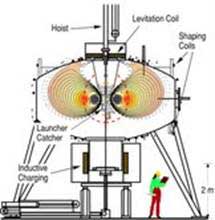 In the LDX vacuum chamber plasma will follow the field lines towards and through the floating dipole superconducting magnetic coil. Photo courtesy of MIT/PSFC |
|
|
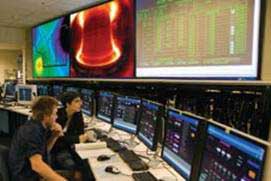
From the control room, graduate students perform experiments on the Alcator C-Mod tokamak
Photo by Paul Riveberg, M.P. McNally
With the help of tools like Alcator Mod-C and LDX, scientists are learning more and more about high-temperature matter and how magnetic fields can be used to confine plasma in the lab, so that someday we can bring the energy of the stars to power plants on Earth. There is a long way to go, but scientists are optimistic that we are getting closer to producing this great source of energy.
Related Links
MIT News: Levitating magnet brings space physics to fusion
The Alcator C-Mod Tokamak Facility
The Levitated Dipole eXperiment
Plasma Science & Fusion Center at MIT
Next Energy News.com MIT Successfully Tests The Levitation Fusion Reactor










